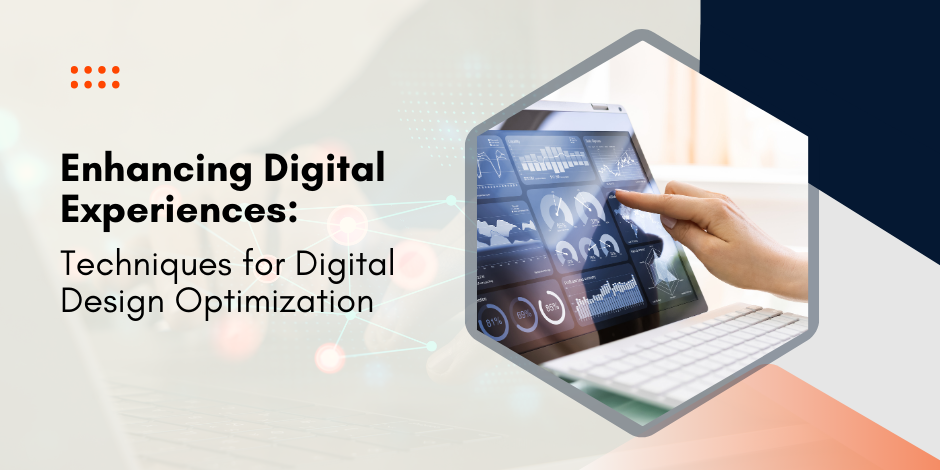Digital Design Optimization: Techniques for Enhancing the Digital Experience

Stay Informed With Our Weekly Newsletter
Receive crucial updates on the ever-evolving landscape of technology and innovation.
Digital design optimization has become an integral part of our lives. Whether we are browsing a website, using a mobile application, or interacting with any digital platform, the design plays a crucial role in shaping our experience.
In this article, we will explore various techniques for optimizing digital design experiences and how they can enhance user satisfaction and engagement.
Understanding the importance of digital design experiences

With the rapid evolution of technology, digital design optimization has become more important than ever before. It goes beyond aesthetics and plays a vital role in conveying information, creating intuitive interfaces, and ensuring a seamless user experience.
The success of a digital product heavily relies on how well its design engages and satisfies its users.
Delving deeper into the realm of digital design optimization, one can appreciate the intricate balance between creativity and functionality.
Designers not only focus on making a product visually appealing but also strive to enhance its usability and accessibility.
By incorporating elements of psychology and human behavior, digital designers aim to create interfaces that resonate with users on a deeper level, fostering a sense of connection and understanding.
The role of digital design optimization in today’s world
In today’s digital-centric world, design is not just about making things visually appealing. It is about solving problems, improving usability, and enhancing the overall user experience.
Digital design encompasses a range of disciplines such as user interface (UI) design, user experience (UX) design, visual design, and interaction design, all working together to create cohesive and impactful experiences.
Moreover, the evolution of technology has led to a shift in consumer expectations, with users demanding more personalized and engaging digital experiences.
This has propelled designers to think beyond traditional design boundaries and explore innovative ways to captivate and retain user interest.
By staying abreast of emerging trends and technologies, digital designers can adapt their strategies to meet the ever-changing demands of the digital landscape.
How digital design impacts user experience
A well-executed digital design has the power to make or break the user experience. It enables users to navigate through a product effortlessly, find what they are looking for, and accomplish their goals efficiently.
By considering factors such as information architecture, intuitive navigation, and clear visual hierarchy, designers can optimize the user experience and increase user satisfaction.
Furthermore, digital design optimization plays a crucial role in establishing brand identity and fostering brand loyalty.
Consistent design elements across different digital touchpoints help reinforce brand recognition and create a cohesive brand experience for users.
By incorporating brand colors, typography, and imagery thoughtfully into the design, designers can evoke emotional responses and strengthen the bond between users and the brand.
Fundamental principles of digital design

Before diving into the techniques for digital design optimisation, it is essential to understand the fundamental principles that guide effective design. These principles act as a foundation for creating visually appealing and functional digital experiences.
The importance of simplicity in digital design
Simplicity is a fundamental principle that drives successful digital design optimisation. By removing unnecessary clutter and distractions, designers create interfaces that are easy to understand and use.
Simple design not only enhances usability but also allows the content to shine, ensuring that users can find relevant information effortlessly.
The importance of simplicity in digital design
Color and typography are powerful tools in digital design optimization. They can evoke emotions, guide users’ attention, and establish brand identity.
Choosing an appropriate color palette and typography that aligns with the brand’s tone and message is crucial for creating visually cohesive and engaging digital experiences.
Techniques for optimizing digital design
Now that we have established the importance of digital design and its fundamental principles let’s explore some techniques for optimizing design and enhancing the user experience.
Applying responsive design principles
In today’s multi-device world, responsive design is a must. Designers need to ensure that their digital products are accessible and visually appealing across various screen sizes and resolutions.
By using flexible layouts and fluid design elements, responsive design provides a seamless experience for users, regardless of the device they are using.
The significance of user interface and user experience design
User interface (UI) and user experience (UX) design are key components of digital design optimization. UI design focuses on creating visually appealing and intuitive interfaces, while UX design delves into understanding the user’s needs and expectations.
By combining these two disciplines, designers can create digital experiences that are both functional and delightful.
The role of technology in digital design optimization
Technology has revolutionized the field of digital design optimization, offering new possibilities and opportunities. Let’s explore how emerging technologies such as artificial intelligence (AI), virtual reality (VR), and augmented reality (AR) are shaping the future of digital design.
How artificial intelligence can enhance digital design
Artificial intelligence is transforming the digital design landscape. By leveraging machine learning and predictive algorithms, AI can automate repetitive design tasks, analyze user behavior, and personalize experiences.
This enables designers to focus on more complex and strategic aspects of design, resulting in more efficient processes and improved user outcomes.
The impact of virtual and augmented reality on digital design
Virtual reality and augmented reality are immersive technologies that are pushing the boundaries of digital design.
These technologies offer a new level of engagement and interactivity, allowing users to experience digital products in a more realistic and immersive way.
Designers can create compelling virtual environments and overlay digital information seamlessly into the real world, enhancing the overall user experience.
Future trends in digital design optimization

As technology continues to advance, new trends and possibilities emerge in the field of digital design. Let’s explore two promising areas that are expected to shape the future of design optimisation.
The rise of voice user interface design
Voice user interface (VUI) design is gaining prominence with the proliferation of voice assistants and smart speakers.
Designers need to adapt their approach to optimize digital experiences for voice interactions. By understanding the nuances of natural language processing and designing conversational interfaces, designers can create intuitive and efficient voice interactions.
The potential of immersive design experiences
Immersive design experiences, such as virtual reality and augmented reality, offer endless possibilities for creating unique and memorable digital experiences.
By incorporating immersive elements into digital design, designers can transport users into different worlds, enhance storytelling, and create lasting impressions.
Conclusion
Digital design optimization is crucial for creating engaging, intuitive, and impactful digital products and experiences.
By understanding the importance of design, applying fundamental principles, and harnessing the power of technology, designers can create experiences that delight users and keep them coming back for more.
If you want to improve your UX & UI design skills or upskill in this domain, download the Institute of Data’s UX & UI Design Program Outline.
Alternatively, we invite you to book a complimentary call with a member of our team to discuss the UX & UI Program in more detail.




